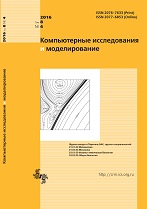|
This article is cited in 5 scientific papers (total in 5 papers)
SOFTWARE
Approaches to cloud infrastructures integration
A. V. Baranova, V. V. Korenkovab, V. V. Yurchenkoc, N. A. Balashova, N. A. Kutovskiyab, R. N. Semenovab, S. Ya. Svistunovc
a Laboratory of Information Technologies, Joint Institute for Nuclear Research, 6 Joliot-Curie st., Dubna, Moscow region, 141980, Russia
b Plekhanov Russian State University of Economics, 36 Stremyanny per., Moscow, 117997, Russia
c Bogolyubov Institute for Theoretical Physics, 14-b Metrolohichna st., Kiev, 03680, Ukraine
Abstract:
One of the important direction of cloud technologies development nowadays is a creation of methods for integration of various cloud infrastructures. An actuality of such direction in academic field is caused by a frequent lack of own computing resources and a necessity to attract additional ones. This article is dedicated to existing approaches to cloud infrastructures integration with each other: federations and so called ‘cloud bursting’. A ‘federation’ in terms of OpenNebula cloud platform is built on a ‘one master zone and several slave ones’ schema. A term ‘zone’ means a separate cloud infrastructure in the federation. All zones in such kind of integration have a common database of users and the whole federation is managed via master zone only. Such approach is most suitable for a case when cloud infrastructures of geographically distributed branches of a single organization need to be integrated. But due to its high centralization it's not appropriate when one needs to join cloud infrastructures of different organizations. Moreover it's not acceptable at all in case of clouds based on different software platforms. A model of federative integration implemented in EGI Federated Cloud allows to connect clouds based on different software platforms but it requires a deployment of sufficient amount of additional services which are specific for EGI Federated Cloud only. It makes such approach is one-purpose and uncommon one. A ‘cloud bursting’ model has no limitations listed above but in case of OpenNebula platform what the Laboratory of Information Technologies of Joint Institute for Nuclear Research (LIT JINR) cloud infrastructure is based on such model was implemented for an integration with a certain set of commercial cloud resources providers. Taking into account an article authors' experience in joining clouds of organizations they represent as well as with EGI Federation Cloud a ‘cloud bursting’ driver was developed by LIT JINR cloud team for OpenNebula-based clouds integration with each other as well as with OpenStack-based ones. The driver's architecture, technologies and protocols it relies on and an experience of its usage are described in the article.
Keywords:
EGI Federated Cloud, OpenNebula, OpenStack, cloud bursting, cloud computing, integration.
Received: 16.12.2015
Revised: 21.03.2016
Accepted: 22.03.2016
Citation:
A. V. Baranov, V. V. Korenkov, V. V. Yurchenko, N. A. Balashov, N. A. Kutovskiy, R. N. Semenov, S. Ya. Svistunov, “Approaches to cloud infrastructures integration”, Computer Research and Modeling, 8:3 (2016), 583–590
Linking options:
https://www.mathnet.ru/eng/crm13 https://www.mathnet.ru/eng/crm/v8/i3/p583
|

| Statistics & downloads: |
| Abstract page: | 346 | | Full-text PDF : | 115 | | References: | 47 |
|




 Contact us:
Contact us: Terms of Use
Terms of Use
 Registration to the website
Registration to the website Logotypes
Logotypes








 Citation in format
Citation in format 